Cognitive risk management in construction projects
Developed by David Baldursson
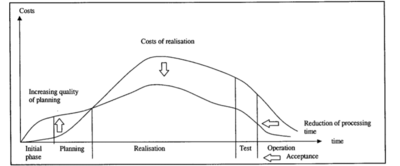
Cognitive risk management in construction projects will be this article main topic. There is a difference in definition of risk and uncertainty, as uncertainty is the absence of information required to make a decision. With the cognitive approach to risks the risk management becomes three dimensional, the risk source, the risk event and the extent of how a decision maker can respond, as the probability of a future event is a property of the decision maker. As risks are from definition deviation from expected value, positive or negative. Decisions are made to eliminate risks and with sufficient knowledge of possible risks turn them into chances, thus introducing risk management. With early realization of possible risk sources it is possible to mitigate high costs that other wise can threaten the project. In order to manage risk and uncertainty it is important to understand four elements of the risk management process of identifying, assess, respond and control of the risk events and their sources. The cognitive model of risk and uncertainty on projects is introduced and the four standpoints of knowns and unknowns, assessment of the risk with the use of tools as the probability/impact matrix. Risks is the decisions makers perception of information, biases can cloud our judgement and it is important to understand them to make a well informed decision.
Contents |
Risk and uncertainty
Risk in theory could be described as the variation from an expected value, negative or positive. According to the Cambridge dictionary, risk is the possibility of something bad happening.[2] It is in general definition something that is interpreted as a loss and can in fact be modeled in mathematics as the probability of the event multiplied with the consequences. Risk is not to be confused with uncertainty as the uncertainty is the absence of information required for the decision that needs to be taken at a point in time.[3] Decisions are made to eliminate risks and with sufficient knowledge of possible risks turn them into chances, thus introducing risk management. By introducing the dimension of time into the definition of risk so that risk events become time based, it is possible to explain risk and uncertainty as a three-dimensional framework of the risk source, the risk event and the extent of how a management can respond and reduce the impact of the risk event.[3]

The cognitive model
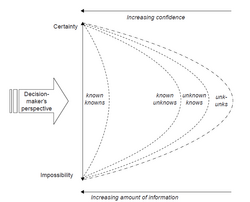
Cognitive action is the mental action or process of acquiring knowledge and understanding through thought, experience, and the senses.[4] When thinking of this in terms of project management on construction projects and decision making, it becomes clear that the information space is a perception or perspective of the project manager. Cognition becomes a big part of elicitation of risk as it depends on the ability and range of the decision maker. Studies on this topic have led to two important points of cognitive biases: the information process of the human mind is limited in its nature, that our experience, feelings and anticipation influence what we actually perceive due to the cognitive simplification mechanisms in our minds, and that the nature of a task influences greatly the strategy chosen to handle the task.[5] From the decision maker’s perspective of a risk source, it is defined in the space from a certainty to impossibility in a cognitive model of risk and uncertainty on projects. The approach of managing risk in the cognitive model is fundamentally about perception of risk events and their impact given the risk sources with the information available at the time of the decision. It makes a difference in the perception of where a probability distribution can be applied to a risk event from data analysis and where no probability distribution can be applied due to no available data.[3]
Rumsfeld's known knowns
"Reports that say that something hasn't happened are always interesting to me, because as we know, there are known knowns; there are things we know we know. We also know there are known unknowns; that is to say we know there are some things we do not know. But there are also unknown unknowns – the ones we don't know we don't know"[6]
Donald Rumsfeld gave this response to a question at a U.S. Department of Defense news briefing on February 12, 2002 when asked about the lack of evidence of the existence of weapons of mass destruction in Iraq. This has since then been used as a multi layered definition of risk and uncertainty from a cognitive standpoint.[3] The known knowns refer to the cognitive condition of risk where the source has been identified and a probability distribution can be applied to the risk source to determine the probability of a risk event. The known unknowns refer to the cognitive condition of uncertainty where the source has been identified and a probability distribution cannot be applied to the risk source to determine the probability of a risk event. The unknown knowns refer to the cognitive condition of uncertainty where the source has been identified and the probability distribution can be applied but the information is kept private, for example the client has information that is not communicated to the design team of a particular project. The unknown unknowns refer to the cognitive condition of uncertainty when the risk source has not been identified and therefor the probabilities are not applicable[3], this could be for example natural disasters that are unforeseen and have unforeseen consequences on the construction project.
Cognitive risk management in construction projects
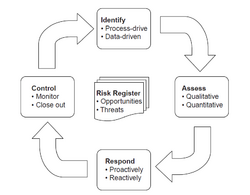
According to the Project management institute, PMI, the definition of Risk management in projects is: “to identify and prioritize risks in advance of their occurrence, and provide action-oriented information to project managers. This orientation requires consideration of events that may or may not occur and are therefore described in terms of likelihood or probability of occurrence in addition to other dimensions such as their impact on objectives”.[7] In order to manage this uncertainty there are various tools and protocols available to assist in the decision making process. But the process of making a good decision and to avoid making bad decision can be divided into four main elements.[3]
The first element is the analysis and identification of the risk source and the possible risk event given the source. This is considered as the most important element of risk management as they can have the biggest impact on the precision of the risk assessment.[8] It is important to know what is to be managed, if a risk fails to be identified it cannot be managed. The second element is the assessment of the risk source where the impact and probability are determined through qualitative and quantitative tools and techniques.[8] The third element is to respond to the risk sources, to take the relative measures and actions to each and every one of them. The fourth element is the control of the risks throughout the project life cycle[3]
Identify the risk sources
When starting a construction project, the standard practice is to consider and assess the possible risk sources, but with new construction projects, new project-related risks arise that need to be identified. Today’s construction field lacks accurate methods to identify the risks implied in construction projects.[8] The most common methods that are used for risk identification process is through experience, organized brainstorming sessions or to produce risk registers containing all knowns.[3] On the following figure is an example of a Risk source structure for risk register on construction projects.
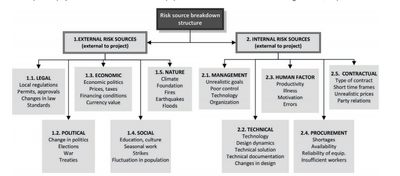
Assess the risk sources
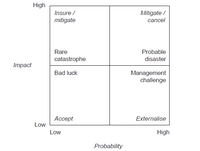
When the risk sources have been identified, the risk assessment compromises of the individual risks and their interrelationship of their effects from the tools and methods of qualitative assessment and quantitative measurement.[1] In this article, the example of the probability/impact matrix, or risk matrix, is taken to consideration. The probability/impact matrix can be used to prioritize risks on the construction project. It classifies the risk sources according to their probability of occurrence and the impact they have. It can be used with a qualitative high and low scale so the known unknowns of the construction project can be assessed or for the assessments of the probability and impact of known knowns.[3]
Respond to the risk sources
After the identification and assessment of the risk sources, the next step would be to respond to the risk sources. Several risk response strategies exist and in this article the following five strategies are addressed:
- Accepting the risk: By accepting the risk an understanding of the risk is implied, its consequences and probability, and the plan is according to the risk event.[10] This is appropriate for very small, very unlikely or very difficult events.[5]
- Externalize the risk: By externalizing the risk the risk is passed on to another party by for example subcontracting. The subcontractor is perhaps in a better position to deal with the risk event. In construction projects this is dependent of the ability of the contractor to assume and reduce the risk.[5]
- Mitigate the risk: To mitigate the risk is to modify the projects mission or scope, not to prevent a risk, but to reduce the probability and impact of the risk event.
- Insure against the risk: It is most effective to insure a project to low probability risks that have catastrophic impacts, such as fire.
- Delay the decision: By delaying important decision, the decision maker is waiting until more information is available. This is appropriate for risks with high impact.[3]
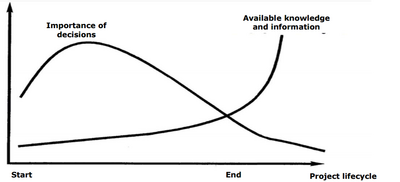
Plan to respond to the risk event
After a risk has been accepted, the risk planning is an important step in case the risk event would happen. The risk plan should address the identified risk event in that manner that the impact is minimized. The most common method of responding to risk events is by implementing contingency plans or slacks in the budget of the project.[3] In order to approach the risk response in an organized method the following steps can be followed:
- Brainstorm response strategies: With the use of for example the impact matrix, where the risk events have been identified, evaluated and prioritized, the risk events with the highest priority could be addressed in a brainstorming meeting to identify as many strategies as possible to address the risk event.[5]
- Evaluate response strategies: After the brainstorming session, the response strategies are evaluated and discussed by the working group.
- Develop response strategies: The evaluated response strategies are then developed by the working group where details and responsibilities of the response strategy are determined.
Control and monitor the risk source
After going through the steps mentioned above, an important step is to control and monitor the identified risk sources. As more information is available with time, a reassessment can be made as the risk event has passed. This includes tracking risks of the risk register, identifying new risks and removing old risks, adjusting risk strategies and monitoring the effectiveness of the made risk responses.[5] When monitoring risks, a risk owner has to be identified. The risk owner is then responsible for the monitoring of the risk. The risk monitoring is one of the most important steps that needs the full commitment of the project management team as the awareness of possible unknown unknowns increases.[3] Therefor a routine information meeting is important where the risk owner, after following up on his risk source, addresses to the project manager to reveal where potential problems could arise and where the risk register is updated.
Limitations and biases
There is a lack of absolute solutions for managing risks as construction projects are often unique and with their own specific project related risks. As this article has reviewed, it is the decisions makers perspective that is of the most importance. The decisions made are often made with prejudice for the available information. This behavior, called cognitive biases, may therefor add to the uncertainty of the project life cycle. Many different cases of biases have been studied and here we will mention some:
- Optimism bias: When the decision maker is overly optimistic about the outcome and underestimates the possible bad outcome. This can refer to wishful thinking or overconfidence in decision making[12].
- Loss aversion: When the decision maker is risk averse and tends to avoid losses rather than win. This can refer to the term anchoring, when the first estimate of an outcome is anchored and new information is used to adjust the first estimation rather than reevaluate[3]. An example could be a project manager of a construction project anchoring on first estimation of budget and schedule.
- Confirmation bias: When the decision maker seeks out to interpret information that only confirms his prior perceiving[12].
- Availability: When the decision maker makes his decision based on recent experience rather than exploring the probability distribution. An example is a project manager basing his decision on similar recent project that without the evaluation of if the outcome was a luck[3].
When in manage of a construction project, it is estimated that 75% to 90% of the time spent, is spent on communication[13]. It is therefore important of realizing how judgement is a matter of perspective and that the decision can be biased. Construction projects are inherently complicated due to their uncertain nature. When assessing and identifying risks, it is impossible to know to what extent the risk magnitude is. We cannot evade the risk and uncertainty of a construction project all together, but we can prepare us to deal with the events to happen. This is why proper risk management is vital throughout a project's lifetime. Risk management is very subjective, and cognitive risk management is dependent on the level of information available at the time of decision and the risk preferences of decision makers and biases. Some tend to seek for more risk than others due to their circumstances or nature.
Further reading
- Winch, G.M. (2010) Managing Construction Projects: An Information Processing Approach, Second Edition. Oxford: Wiley-Blackwell Publishing.
Chapter 13 handles the practice of managing risk and uncertainty in a construction project. The article is inspired and based on this chapter.
- Vick, S. G. (2002) Degrees of Belief: Subjective Probability and Engineering Judgment. Reston, VA, ASCE Press.
A profound and stimulating reflection on risk and uncertainty in construction projects which argues for the role of judgement rather than calculation in effective engineering.
- Project Management Institute (2009) Practice standard for project risk management. Project Management Institute, Inc.
Project Management Institute practice standards are guides to the use of a tool, technique, or process identified in Project Management Body of Knowledge ( PMBOK ® Guide – Fourth Edition) or other PMI standards.
- Cretu, O., Stewart, R. and Berends, T. (2011) Risk Management for Design and Construction, John Wiley & Sons, Inc.
This text provides a balance of theory, technique and facilitation. The emphasis is on providing a practical and proven framework for risk management on real projects.
- Chatzipanos, P. A. & Giotis, T. (2014) Cognitive biases as project & program complexity enhancers: the Astypalea project.
This paper tries to illustrate the role of cognitive biases as complexity enhancers in programs and projects.
References
- ↑ 1.0 1.1 Martin Schieg (2006) Risk management in construction project management, Journal of Business Economics and Management, 7:2, 77-83
- ↑ ‘‘Cambridge dictionary: Risk‘‘
- ↑ 3.00 3.01 3.02 3.03 3.04 3.05 3.06 3.07 3.08 3.09 3.10 3.11 3.12 3.13 3.14 3.15 3.16 3.17 Winch, G.M. (2010) Managing Construction Projects: An Information Processing Approach, Second Edition. Oxford: Wiley-Blackwell Publishing
- ↑ ‘‘Oxford dictionary: Cognition‘‘
- ↑ 5.0 5.1 5.2 5.3 5.4 Cretu, O., Stewart, R. and Berends, T. (2011) Risk Management for Design and Construction, John Wiley & Sons, Inc.
- ↑ ‘‘Defense.gov News Transcript: DoD News Briefing – Secretary Rumsfeld and Gen. Myers, United States Department of Defense‘‘
- ↑ Project Management Institute (2009) Practice standard for project risk management. Project Management Institute, Inc.
- ↑ 8.0 8.1 8.2 Maytorena, E., Clarke, S., Dalton, M., Kiely, T., & Winch, G. M. (2004). Identifying project risks: a cognitive approach. Paper presented at PMI® Research Conference: Innovations, London, England. Newtown Square, PA: Project Management Institute
- ↑ Dunović, I., Radujković, M., Vukomanović, M. (2013). Risk register developement and implementation for construction projects. Retrieved from http://casopis-gradjevinar.hr/assets/Uploads/JCE_65_2013_1_4_722_EN.pdf
- ↑ Ehsan, N., Alam, M., Mirza, E., Ishaque, A., (No year). Risk Management in construction industry. Retrieved from http://www.meeting.edu.cn/meeting/UploadPapers/1282726331593.pdf
- ↑ Thuesen, C. (2017). Planning and Management of Construction. Presentation in class, June 2nd, 2017
- ↑ 12.0 12.1 Chatzipanos, P. A. & Giotis, T. (2014). Cognitive biases as project & program complexity enhancers: the Astypalea project. Paper presented at PMI® Global Congress 2014—EMEA, Dubai, United Arab Emirates. Newtown Square, PA: Project Management Institute. Available at http://www.pmi.org/learning/library/cognitive-biases-complexity-enhancers-projects-1454
- ↑ Ashari, A. (2016). Cognitive Biases in Project Management. Retrieved from https://project-management.com/cognitive-biases-in-project-management/